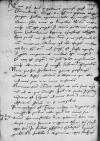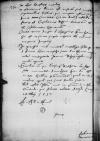Scripsi Dominationi Vestrae Reverendissimae praeterito tempore semper habita opportunitate, sed nullum responsum obtinui, praeter unas ex ⌊Bruxellis⌋. Non enim metuo mihi non esse scriptum, sed errore portantium amissas. Cum cubicularius regius ⌊Gersdorff⌋ rediisset, dixit se ad me habere litteras, quas post paululum non invenit. Alius item ille ⌊Spigel⌋ nullas attulit. Si enim nil scriptum est, facile cognosco id propter occupationes multas esse omissum. Si vero est scriptum, non solum doleo consolationem mihi ademptam, sed magis laborem Dominationis Vestrae superinscribed⌈Dominationis VestraeDominationis Vestrae superinscribed⌉ esse perditum.
Nova, quae hic habentur, paucis perstringam. Oratores regii redierunt ex ⌊Moscovia⌋, qui illic indutias pro uno anno confecerunt. Nuntius etiam a ⌊Turco⌋ rediit, ut aiunt, sine responso, nam ad ea, quae commissa habuit, orator imperatoris responsurus est (⌊Gritum⌋ advenire dicunt) nec tamen affuturum sperant in 5 mensibus. Rumor etiam est ⌊Turcas⌋ multos in ⌊Ungariam⌋ advenisse, de quibus credo apud vos certius sciri. Dominus ⌊Szamoiski⌋ [ref]erendarius maiestatis regiae on the margin⌈ref hidden by binding⌈[ref]ref hidden by binding⌉erendarius ⌊maiestatis regiae⌋[ref]erendarius maiestatis regiae on the margin⌉ die Lunae, extremum diem vitae clausit, cuius domus e regione reverendissimi domini Cracoviensis cessit domino ⌊Ioanni Andreae⌋ phisico, scholasticum Lanciciensem procul dubio habebit dominus ⌊Ioannes Drzevicius⌋, nepos archiepiscopi.
 BCz, 243, p. 230 De aliis beneficiis me latet.
BCz, 243, p. 230 De aliis beneficiis me latet.
Dominus ⌊Severinus Bonar⌋ etiam consortem suam amisit superioribus diebus. Qui nuper officium consulatus hidden by binding⌈[latus]latus hidden by binding⌉ huius terrae civitatis (ut ita dicam) reddidit, nam hidden by binding⌈[am]am hidden by binding⌉ factus est consiliarius regni. Datus enim est illi castellanatus Ziarnoviensis. Orator ⌊ducis Prussiae⌋, dominus ⌊Georgius Kunheim⌋ hic est, ut sentio, super negotio illo ordinis aut potius imperii.
In ⌊Prussia⌋ nil mutatum intelligo, praeter quod domina Anna Hannowsche, soror Dominationis Vestrae Reverendissimae, nupsit hidden by binding⌈[sit]sit hidden by binding⌉ cuidam iuris perito ⌊Ioanni Rheynegk⌋, mihi nondum cognito.
⌊Siculus⌋ noster, qui ⌊Erasmi written over o⌈oii written over o⌉ Rotherodami⌋ laudes solet minuere, divulgat hic, eum esse in tota ⌊Gallia⌋ excommunicatum. Quod an ita sit hidden by binding⌈[it]it hidden by binding⌉, melius apud vos sine dubio scitur.
Nil restat. Iterum me in gratiam Dominationis Vestrae Reverendissimae commendo. Quae feliciter valeat.
 BCz, 243, p. 230 De aliis beneficiis me latet.
BCz, 243, p. 230 De aliis beneficiis me latet.


